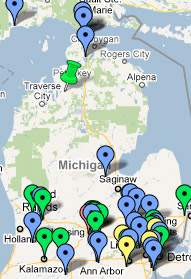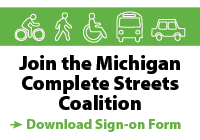By Brad Neumann, Michigan State University Extension.
Three years after Michigan’s complete streets legislation became law, design guidance is improving and research into the benefits of complete streets is continuing to emerge, yet funding for projects is lean and implementation seems limited.
The concept of complete streets has officially been on the radar of local governments and transportation agencies in Michigan since 2010, when communities were given new planning and coordination responsibilities related to multimodal transportation planning. Yet some practitioners say there has been little progress made beyond the scattered adoption of resolutions and ordinances. Has the movement towards roadways planned, designed, and constructed to provide appropriate access to all legal users…whether by car, truck, transit, assistive device, foot or bicycle, stalled?
Some proponents of complete streets point to transportation engineers as an obstacle, saying the rule book that engineers have to follow is not accommodating to non-motorized users. However, in September 2013 the Federal Highway Administration (FHWA) publically supported two sets of guidelines that are oriented towards the creation of more walkable and bikeable urban environments. The FHWA encouraged transportation agencies nationwide to turn to the National Association of City Transportation Officials (NACTO) Urban Bikeway Design Guide and the Institute of Transportation Engineers (ITE) Designing Urban Walkable Thoroughfares. The two new guidelines go beyond the American Association of State Highway and Transportation Officials (AASHTO) ‘green book’, which is the principal national transportation design resource. So, it seems the engineering guidance is out there and planners can no longer blame the engineers’ rule books.
Other critics say there has been too much emphasis on promoting the environmental, health, recreation and lifestyle benefits of increased walking and cycling. They say the message needs to refocus on the safety and economic benefits of complete streets. Indeed, there is substantial research connecting health to community design and evidence shows a majority of people currently fall into the recreational cycling category of “Interested but Concerned” (that is, interested in cycling, but concerned about safety). Regarding safety, for decades research has shown that a cyclist riding on the sidewalk is at least twice as likely to get in an accident than a cyclist riding in the street (Wachtel and Lewiston, 1994), and streets with bike lanes have significantly lower crash rates than either major or minor streets without any bicycle facilities. However, even cities with relatively good cycling infrastructure still have cyclists on the sidewalk. When it comes to economic benefits, while there is evidence of increased retail sales resulting from the installation of cycling facilities, at least one researcher points to the need for more rigorous and detailed evidence on the economic impacts of cycling. So, perhaps the research and message is still evolving and that is affecting the implementation of complete streets projects.
Certainly funding for such programs has an impact on implementation. For several years in Michigan municipal finances have been lean, and state and federal transportation funding for non-motorized projects has been reduced, most notably with the MAP-21 (the Moving Ahead for Progress in the 21st Century Act, signed July 6, 2012) amendments to the Federal-Aid Highway Program, which reduced total funding for the Transportation Alternatives Program, the Recreational Trails Program, and the Safe Routes to School Program by 26 percent from fiscal year 2009 funding levels.
Despite the pitfalls and challenges, the Michigan Complete Streets Coalition highlights several communities that have recently passed complete streets resolutions and/or ordinances and the Michigan Department of Transportation continues to expand its support for complete streets projects. Other Michigan communities are finding low cost ways to implement complete streets – strategies that require little more than re-striping and new signage (see MSU Extension news article Road diets can improve pedestrian safety without compromising capacity). Additionally, bicycle and pedestrian advisory committees are conducting cycling safety education and launching public service announcements for greater awareness among motorists and cyclists alike. These low cost measures can go a long way to improving the environment for non-motorized users.
So, yes, pedestrian-oriented engineering guidance is out there, and yes, more research is needed, and yes, funding is a challenge, and yes, progress is being made. To learn more about the status of complete streets in Michigan, visit the Michigan Complete Streets Coalition website. Training is also available on complete streets in Michigan; just contact a Michigan State University Extension land use educator at the Land Use Education Services page.
This article was published by Michigan State University Extension. For more information, visithttp://www.msue.msu.edu. To contact an expert in your area, visit http://expert.msue.msu.edu, or call 888-MSUE4MI (888-678-3464).
Originally posted on October 17, 2013 by Brad Neumann, Michigan State University Extension. Used here with Permission.
















1 comment
Comments feed for this article
October 22, 2013 at 8:46 pm
Cory Johnston
While I am disappointed that so little has been done, at least in my area, there is hope. MDOT is doing resurfacing and restriping on a regular basis and much can be done with paint to improve transportation for all. ADA requirements also require upgrading of many facilities based on the amount of work to be done. This has now been more clearly defined. There are also CMAQ (Congestion Mitigation and Air Quality) funds that can easily be used for many things that are part of the Complete Streets program. Still lots to do and a lot of people to educate, but there are possibilities.